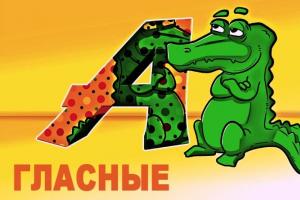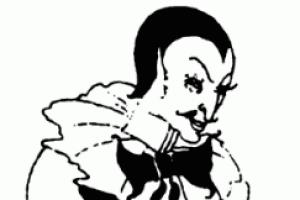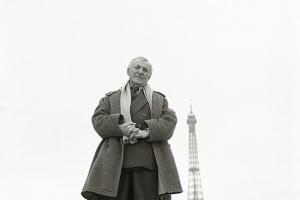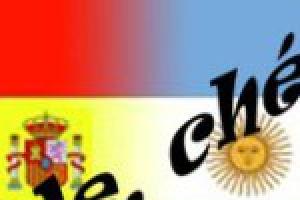Target: Clear sound pronunciation; highlighting the stressed vowel sound. Analysis of a sound series of three vowels; reproduction of a sound series of three vowels. Exercise in the use of the nominative plural of nouns with endings - and, - a. Working on a proposal. Develop memory, attention, logical thinking. Introducing the letter “I”.
Equipment: dolls, pictures depicting objects with the letter “I”, red circles, “traffic light” manuals, cut-out alphabet, counting sticks, magnetic board, strips of paper for a sentence diagram.
Progress of the lesson.
1. Organizational moment.
Remember the vowel sounds that were taught in previous lessons.
A.O.U. Then, based on silent articulation, children guess
combinations of 2, 3 vowel sounds, pronounce them, determine
quantity and order.
2. Today guests came - dolls Ivan and Iya - Repeat what they are
name? What is the first sound in their names? (AND). What reminds you
sound "I"? How does a donkey scream? (And - a, and - a, and - a). Today we will
pronounce many words with the sound “I” and get acquainted with the letter
"AND". Picture – Turkey. Isolating the sound “I” from a word. Where
Can you hear the sound “I”? (At first).
- Characteristics of the sound “I” by articulatory and acoustic
- Pronouncing the sound “I” in chorus and one at a time.
- Isolating the sound “I” from a number of vowels. At the sound “I”, children raise red traffic lights (au, io, iu, au, aoi...).
- Sound analysis of a series of three vowels: а у и; a and y; y and a; u a and; and y a;
- Ivan and Iya
- Physical exercise.
- Long and short words. Name: Iya, willow, tools,
- Games “What has changed?”, “Look and remember” (based on pictures).
- Work on the grammatical structure of speech (changing nouns).
- Working on a proposal.
- The letter “I”: finding it in a split alphabet, printing (folded from counting sticks).
signs. (The air passes freely, without obstruction, the sound is sung - a vowel. We denote the vowel sound with a red circle).
(Determination of the first, last sound, determination by ear of the number of sounds, reproduction of sound series in circles).
We went out to play hide and seek,
Look for the letter ‘‘I’’ in words
Game “Recognize the sound”. (Clap your hands if it is in the word).
Willow, turkey, ball, aster, Ira, red, blue, Ilyusha, apple, plums
8. Game “Say the word.”
9. Pronouncing the sound “I” in words. Determining his position. Development of logical memory. (Pictures are displayed by topic).
What are the names of our guests? (Ivan and Iya). They love to play (with toys). And these are musical (instruments). This tree is called (willow). What's sharp and metallic here? (Needle). What are the trees covered with? (Rime). What is another name for such a house? (Hut, hut, hut).
Game “Add the right word”
a) Trees in (frost). b) We are not afraid (of the turkey). c) Mom sews (with a needle). d) The fox made an ice hut. e) We play musical (instruments). f) We have a lot of (toys) in our group.
10. Selection of related words.
What can you do with toys?…. (Play). We have a lot... (toys). Today I invite you to ... (game). With me you will .... (play).
The words: game, play, toy, toy are called related. This is a family of words.
We brought you gifts,
Whoever wants it will take it
Here's a doll with a bright ribbon,
Horse, top and plane.
game, toys (clap syllables).
Horse-horses, fly-flies, ant-ants,
Mak-maki, snail-snails, book-books.
Complete the sentence and make an outline:
.....(horses) are grazing in the meadow.
...... (children) are sitting at the table.
Summary of the lesson.
What sound and what letter did we meet today?
What did we learn in class? Remember the pictures with “I”.
Alena Korneychuk
Summary of educational activities for teaching literacy “Sounds and letters”
SOUNDS AND LETTERS.
Goals: Introduce: - with concept sounds and letters; - give the concept of vowel sound, consonant sound; - with designation sounds in writing.
Everything we say, read, write, what is it called?
(Our speech).
What does our speech consist of? (from words)
What about the words? (from sounds)
Sounds we pronounce and hear.
A we see the letters, write and read.
Sounds There are vowels and consonants.
Vowels sounds. Vowels different sounds, but very friendly, they all love to sing. Their voices sound beautiful and clear. Let's sing these together sounds! - AUOOIEEE.
The air flows freely through the mouth, there are no different obstacles. The voice calls, the voice sings. The sound is vowel.
Vowels sounds are always indicated in red.
Game exercise “Name the pictures”
(Picture card : duck, needle, glasses, bus)
Consonants sounds.
Consonants agree
Rustle, whisper, creak,
Even snort and hiss,
But I don’t want to sing to them.
Consonants can't sing sounds, do not like. Consonants sounds we pronounce with the help of lips, tongue, teeth, palate, there is an obstacle in their pronunciation. They are pronounced briefly. Some are loud, others are deaf. Some are hard, others are soft. Look at them. What color is their outfit? (children's answers).
If consonant the sound is solid, then he puts on a blue outfit, and if it’s soft, then he puts on green. Look, there are consonants sounds, who have both blue and green colors in their outfit. What do you guys think this means? (children's assumptions).
It means that two sounds: both, hard and soft. Such a lot of sounds, look (the teacher shows sounds on the board) .
But there is sounds, which or only hard and soft girlfriends he does not have. Or vice versa, only soft sound, but there is no solid girlfriend.
Let's name only the hard ones sounds(the teacher shows and everyone calls in unison sounds) - [f][w][ts].
Now let's just name the soft ones sounds - [h’][sch’][th’].
Look at the soft ones sounds There is this comma at the top right. She indicates that the sound is soft. This comma is called an apostrophe.
Game exercise “Name the pictures” Which words begin with hard and which with soft? sound?
(Cards-pictures: shirt, belt, squirrel, drum, light bulb, leaf)
The teacher asks the children how the vowels differ sounds from consonants?
(when we pronounce vowels sounds lips and teeth do not interfere with us, and consonants encounter an obstacle on their way).
Physical education lesson Children have cards with letters. They run in all directions, at the signal - split into 3 teams: vowels, hard consonants and soft consonants. Three house: blue, green, red.
Remind you that vowels sounds We denote them in red and consonants in blue or green.
Game exercise "Find the picture" Circle the pictures whose names begin with a vowel. red sound, and for a consonant - blue.
(Cards with pictures : axe, pen, window, towel, bow)
Circle the pictures whose names end with a vowel. red sound, and for a consonant - blue.
(Cards with pictures :needle, ball, duck, umbrella)
Guys, we can hear everything sound, is it possible to see him?
Sounds indicated in writing letter. And in the next lesson we will begin to get acquainted with letters.
Publications on the topic:
Homework for teaching children literacy “Vowel sounds and letters” Card 1. Sound and letter A, and 1. The sound “A” is a vowel (it is formed with the help of the voice, it can be sung, drawn, it is not met by an air stream.
Summary of a literacy lesson in the senior group “Reinforcing the sound [K]-[K’], the letter K. Working on a sentence” Goal: Reinforce the sound K (Kb, letters K. Work on a sentence. Educational objectives: 1. Continue learning to differentiate hard sounds.
Summary of a lesson on teaching literacy “Hard consonant sound [w], letters Sh, sh. Shea combination" Topic: Hard consonant sound [sh], letters Sh, sh. Shea combination. Purpose: to introduce the hard consonant sound sh, the spelling of the combination shi;.
Summary of a literacy lesson in the preparatory group “Sounds [z, z’]. Letters z, z'" Didactic goal: to develop children's knowledge about the sounds [z], [z"] and the letters Z z Type of lesson: acquaintance with new sounds and the main letter.
MDOU kindergarten No. 32 in Rybinsk. Plan - summary of educational activities for teaching literacy in a preparatory group for school on the topic: “Sounds G - K, letters.
GCD scenario for teaching literacy: “Sounds [k] - [k], letter “K”” in the preparatory group. Scenario of direct educational activities for teaching literacy: “Sounds [k] – [k], the letter “K”” in the preparatory group Purpose:.
Summary of a literacy lesson “Sounds [s], [s’]. Letter C" 1. Correctional and educational goals. Strengthen the skills of distinguishing and pronunciation of sounds С, Сь in syllables, words, sentences; exercise.
Literacy lesson “Consonant sounds [з’], [з]. Letters Z, z" Literacy lesson
The most important part of speech are words; we pronounce, write and read them, and from them we put together phrases and sentences. They consist of letters and sounds that have become so firmly established in our lives that we hardly notice them.
Letters and sounds are not the same thing, although they are closely interrelated concepts. We write, see and read letters, and we pronounce and hear sounds. Letters are graphic written symbols, while sounds are the acoustic component of words and human speech in general. In different words, the same letter sometimes corresponds to different sounds.
“In the beginning there was the word. Then words, words, words..." (author Vladimir Kolechitsky).
“The word is given to a person not for self-satisfaction, but for the embodiment and transmission of that thought, that feeling, that share of truth and inspiration that he possesses - to other people.” (author V. Korolenko).
Various branches of linguistic science study letters and sounds. Studies sounds phonetics, and alphabetic characters - graphic arts. Spelling letters is a prerogative spelling .
The collection of letters of any language makes up its alphabet. The letters of the Russian language are divided into consonants, vowels and auxiliaries. Auxiliary signs include those that do not carry sound information - hard and soft signs.
Consonants and sounds of the Russian alphabet
Consonant sounds and letters are characterized by the fact that during their pronunciation a certain obstacle appears in the path of air in the oral cavity. As a result, noise is necessarily present in the acoustic sound of consonants. They got the name “consonants” because they almost always stand next to vowels or in the same word with them.
There are a total of 21 consonant letters in the Russian language:
| b | V | G | d | and | h | th |
| To | l | m | n | P | R | With |
| T | f | X | ts | h | w | sch |
Another characteristic feature of consonants is that they cannot be chanted. The pronunciation of sibilant consonants can be stretched (for example: With , f , w , sch), but “singing” will not work.
As noted above, consonants in words almost always coexist with vowels. However, there are a limited number of words that consist only of consonants. Along with prepositions To , With or particle b, these are some foreign proper names ( Krch- Prague region; Armenian name Mkrtch, which in Russian is sometimes written with a vowel - for euphony), as well as interjections like brr or shh .
The classification of consonant letters and sounds in the Russian language is based on acoustic criteria.
Voiced and voiceless consonants
Those consonants whose pronunciation consists only of noise are called voiceless. In contrast, consonants formed by sound and noise are called voiced.
The letter stands apart th(and short). According to its acoustic sound, it is classified as a voiced consonant, however, it is impossible to pronounce it in isolation. Letter th can only be pronounced together with a preceding or following vowel sound, for example [yy], [yy], etc.
Paired and unpaired consonants
Most voiced consonants correspond to certain unvoiced ones. Such letters that are consonant with each other are called paired. There are also consonants that do not have a pair. Among them there are also deaf and voiced, and they are called unpaired .
| Paired voiced and voiceless | Unpaired voiced | Unpaired deaf |
|---|---|---|
| b - p | l | X |
| v - f | m | ts |
| g - k | n | h |
| d - t | R | sch |
| f - w | th | |
| z - s |
Soft and hard consonants
The pronunciation of consonants in words can be hard or soft. If the sound is pronounced softly, the tongue moves forward slightly, approaching or touching the upper palate. When pronouncing hard sounds, the tongue does not move forward (but the tongue can touch the upper palate due to an upward movement).
Most consonants form both hard and soft sounds, but there are some exceptions. In particular, the letters and , ts , w always have a hard sound, and the letters th , h , sch- soft.
In other cases, the hardness or softness of the consonants is determined by which letter comes after them.
If the consonant is accompanied by letters A , O , at , uh , s , ъ- then you get a solid sound. The same applies if a consonant is at the end of a word or another consonant comes after it.
If the consonant is accompanied by letters e
, e
, And
, Yu
, I
, b- then its sound will be soft.
Video lesson
Hissing and whistling consonants
Some of the consonants in Russian are pronounced like hissing. These are the sounds and , w , sch , h, which are called sibilant consonants.
Another group of consonant sounds, when leaving the oral cavity, forms acoustic vibrations that resemble a whistle. These are the sounds h , With , ts- whistling.
The properties of hissing and whistling consonants are especially noticeable when they are pronounced for a long time.
One of the important features of these sounds is that most speech defects are associated with their pronunciation. For this reason, special attention should be paid to working with hissing and whistling consonants when teaching children. It is important to note that speech deficiencies associated with these sounds may be amenable to speech therapy correction.
Russian vowels and sounds

Unlike consonants and letters, a characteristic feature of vowels is that when they are pronounced, air passes through the oral cavity freely. As a result, vowel sounds can not only be easily stretched, but also chanted. Another distinctive feature is that they can be pronounced as loudly as you like, at the full strength of your voice.
Through vowels and sounds, consonants are combined into syllables. Each syllable has only one vowel. The number of other letters - consonants, hard and soft signs - may be different. Words can consist of one or more syllables: ros-pis, breaking , yard , painting .
The number of vowels in the Russian language is 10:
| A | e | e | And | O | at | s | uh | Yu | I |
And there are only 6 vowel sounds: [a], [i], [o], [u], [s], [e]. The vowels corresponding to them are monophonic. The remaining 4 vowels are e , e , Yu , I- two-voiced, and separately pronounced as [ye], [yo], [yu], [ya]. At the same time, in words these letters mean one sound (examples: squirrel, ball, went, key).
As with consonants, there are a number of Russian words that consist only of vowel sounds. These are pronouns - I , her; unions - And , A; prepositions - at , O; interjections - uh , aw .
Stressed and unstressed vowels
In words, vowel sounds can be stressed or unstressed.
- If the vowel in a word is under stress, it is read more clearly, with more emphasis and a little more drawn out.
- In the absence of stress, vowels in words are read less clearly. Accordingly, the unstressed position is a weak position for them, and the position in a stressed syllable is a strong position.
As a rule, in traditional writing, words are not stressed. If necessary, they are indicated by the sign “acute” - a small “/” stroke above the vowel letter.
Video lesson
Designations of sounds during phonetic parsing of a word
Phonetic or sound analysis of a word serves the purpose of displaying and parsing its correct pronunciation. Both words and individual letters can be designated phonetically.
Designations of sounds, unlike letters, are enclosed in square brackets. A graphic recording of the pronunciation of a word is called transcription.
The basic rules according to which sounds are designated during phonetic analysis of a word are as follows:
- The hardness of consonants does not have any designation, but softness is indicated by an apostrophe. For example, if [b] is a hard sound, then [b’] is soft.
- A long sound in transcription is indicated by a colon, for example: cash register- [kas:a] .
- Not always, but often, emphasis is placed in the transcription of words. For example: wave- [walla].
- The soft sign and the hard sign do not have a sound pronunciation, therefore there is no display during phonetic analysis.
Video lesson
How to teach children to distinguish between hard and soft sounds
Sometimes children may have difficulty distinguishing between hard and soft consonants. In this case, there are some techniques that make it easier to understand the topic.
First of all, you need to explain to the child that the concepts of hardness and softness refer not to consonant letters, but to their sounds. And that the same letter can sound both hard and soft. Let me give you an example: “ b" - the words ram - white, " R" - work - belt, " l" - horse - swan.
When explaining the exception letters, for better memorization it is recommended to write them like this:
- th , h , sch
- and , w , ts
You need to make it clear to the child that the underlined letters seem to be “sitting on pads” - the pads are soft and the letters are also soft.
In order for the child to remember well before which vowels the letter becomes hard or soft, you can use the following technique: first, with a serious expression on your face, read a syllable with a hard consonant - and then, with a smile on your face, read another syllable where this consonant is soft. Then, do the same with other letters and syllables. For example: la — la , mu — mi , zo — son, bo — byu , ry — ryo etc. A child associates soft pronunciation well with a smile, and hard pronunciation with seriousness and severity, which allows him to associatively remember the material.
Gradually you need to improve your skills and do the same exercises with simple words, such as: Mother , dad A - uncle , aunt etc. As you memorize, you should move on from simple words to more complex ones. Explanations and exercises must be gradually alternated with tasks: write words and then ask which consonants in them are hard and which are soft.
You can also suggest another exercise: make signs with words in which soft consonants are written in one color, and hard consonants in another. For example:
- N O S I K
- CARPET
- NUMBER
- WARM
There are many options, but it is advisable to choose among them those that your child likes best. This contributes to better perception of the material, its memorization and practical assimilation.
Video lesson
Some interesting and useful information
- Sounds and words can be formed without human intervention. A well-known example is the pronunciation of words by birds of the parrot family. As for individual sounds, they can also appear in inanimate nature - with the rustling of leaves, gusts of wind, splashing of waves. This cannot be said about letters - after all, only their meaningful writing can be recognized as a letter designation, and this is characteristic only of people.
- Despite the small number of words consisting only of vowels, they can be used to form a sentence: “Eh, and me?”
- Almost all words in the Russian language containing the letter " f", are of foreign language origin. Only in relation to rare words (for example: eagle owl) Russian origin is assumed, but this has not been definitely proven.
- All words starting with the letter " th", also foreign languages. For example: iodine, yogurt, iota, Yemen, Yokohama, Yorkshire, etc.
- Letter " e" in words almost always carries an emphasis. There are very few exceptions to this rule - these are words of foreign origin ( Königsberg surfers ), as well as complex words containing three or four numerals - ( twenty-three digit , four-door , three thousandth ). It should also be noted those rare situations when one word contains two letters “ e", one of which becomes stressed, and the other - unstressed ( three-star , four-wheeled , airplane lift , three ruble ).
- The Russian language has many words with unusual letter combinations. For example, words in which the same vowel is repeated three times in a row: snake eater , animal association , long-necked. Word with 7 consonants in a row: countermeeting (Maybe, occasionalism ). Words with three soft signs: seductiveness , diminutive , multifunctionality , charm etc. A word with two soft and one hard signs: courier . One-syllable word of 8 letters: in passing. Many other interesting examples can be given.
- Any letter has a certain repetition frequency, the most commonly used letters in the Russian language are O , e , A , And , T , n , With , R. This phenomenon is used to recognize cipher messages.
Knowledge of letters and sounds, their spelling and pronunciation is the basis of language literacy. In turn, good command of spoken and written language is one of the indicators of a person’s erudition, and the skills of reading and understanding text are the basis for knowledge of other sciences. After all, the lion's share of information in the modern world is comprehended by reading or listening, and only a small part of it is through personal experience.
Speech sounds- a class of sounds formed as a result of human pronunciation activity.
This is part of the many acoustic vibrations that are perceived by the human auditory system. Unlike other sounds of animate and inanimate nature, they are used to form more complex complexes that serve as specific “shells” of significant units - morphemes or words.
All letters of the Russian language are divided into vowels and consonants.
There are 10 vowel letters:
A E Y I O U Y Y Y Y
There are 21 consonants:
B C D D F G H J K L M N P R S T F
Sound speech in writing is conveyed using special graphic signs - letters. We pronounce and hear sounds, and we see and write letters. A list of letters in a certain order is called an alphabet. The word “alphabet” comes from the names of the first two letters of the Greek alphabet: a – alpha, b – beta (in modern Greek – vita).
The modern Russian alphabet has 33 letters. Each letter has a printed or handwritten, uppercase and lowercase version.
Sound- This is the minimum, indivisible unit of sounding speech. Letter- a graphic sign to indicate sound in writing, that is, a drawing. Sounds are pronounced and heard, letters are written and perceived by sight. There are sounds in any language, regardless of whether it is written or not; spoken speech is primary in relation to speech written in letters; in phonographic languages, letters reflect spoken speech (unlike languages with hieroglyphic writing, where meanings, rather than sounds, are reflected).
Unlike other linguistic units (morphemes, words, phrases, sentences), sound itself has no meaning. The function of sounds is reduced to the formation and differentiation of morphemes and words (mal - mole - soap).
There are 33 letters in the Russian alphabet:
Aa – “a”, BB – “be”, Vv – “ve”, Gg – “ge”, Dd – “de”, E – “e”, Yoyo – “e”, Zh – “zhe”, Zz – “ze”, Ii – “i”, Yi – “y”, Kk – “ka”, Ll – “el”, Mm – “em”, Nn – “en”, Oo – “o”, Pp – “pe” ", Rr – “er”, Ss – “es”, Tt – “te”, Uu – “u”, Ff – “ef”, Xx – “ha”, Ts – “tse”, Chch – “che”, Shsh – “sha”, Shchsh – “sha”, ъ – “hard sign”, Yы – “y”, ь – “soft sign”, Ee – “e”, Yuyu – “yu”, Yaya – “I”.
The Russian alphabet is called Cyrillic or Cyrillic.
In the Russian language, not all speech sounds are designated, but only the main ones. The Russian language has 43 basic sounds - 6 vowels and 37 consonants, while the number of letters is 33. The number of basic vowels (10 letters, but 6 sounds) and consonants (21 letters, but 37 sounds) also does not match. The difference in the quantitative composition of basic sounds and letters is determined by the peculiarities of Russian writing.
That is, all letters of the Russian language are divided into three groups:
1) letters that do not represent sounds;
2) letters denoting two sounds;
3) letters denoting one sound. The first group includes the letters ъ, ь, which do not denote any sounds: day - [d'en'], volume - . The second group includes the letters e, e, yu, i. To the third - all the rest.
In Russian, hard and soft sounds are indicated by the same letter.
The six basic vowel sounds are represented by ten vowel letters:
[and] - and (darling).
[s] - s (soap).
[a] – a (May) and I (mine).
[o] - o (my) and e (tree).
[e] – e (this) and e (chalk).
[u] – u (bush) and yu (yule).
Thus, to designate the four vowel sounds ([a], [o], [e], [u]) there are two rows of letters:
1) a, o, e, y;
2) I, e, e, yu.
The letters i, e, ё, yu perform two functions:
after a consonant, they signal that the preceding consonant represents a soft consonant.
After vowels, at the beginning of a word and after the separating ъ and ь, these letters represent two sounds – the consonant [j] and the corresponding vowel:
I – , e – , e – , yu – .
For example:
1. after vowels: chews
2. after the separators ъ and ь
3. at the beginning of a word
The sound [j] is indicated in writing in several ways:
after vowels and at the end of a word - the letter y;
at the beginning of a word and between two vowels - using the letters e, e, yu, i, which denote the combination of a consonant [j] and the corresponding vowel;
The presence of the sound [j] is also indicated by the separating ъ and ь – between the consonant and vowels e, ё, yu, ya.
The letters ъ and ь do not represent any sounds.
The separating ъ and ь signal that the following e, ё, yu, i designate two sounds, the first of which is [j].
Non-separating:
1) indicates the softness of the preceding consonant
2) performs a grammatical function.
For example, in the word mouse ь does not indicate the softness of the preceding consonant, but signals that the given noun is feminine.
In addition, the same letter can represent different sounds. For example, the letter m can denote the sounds [m] and [m’]: mil – [m’il], soap – [soap]. The letter b can denote the sounds [b], [b'], [p], [p']: I will - [I will], beat - [b'it'], oak - [dup], Ob - [op' ].
Voiced consonants at the end of a word and before voiceless consonants (i.e. in a weak position) sound like paired voiceless consonants: booth - bu[t]ka, order - prika[s]. This phenomenon is called stunning.
Voiceless consonants before voiced ones (i.e. in a weak position) sound like their paired voiced consonants: threshing - molo[d']ba, request - pro[z']ba. This phenomenon is called voicing.
Strong positions for deafness-voicing for consonant sounds are positions before vowels and before r, l, m, n, th, v. Spelling errors are most often made when the consonant is in a weak position.
One sound can also be indicated by combinations of letters, for example:
- [sh’] – sch, zch, zhch: counting – [sh’]yot, happiness – [sh’]astye, driver – vo[sh’]ik, man – mu[sh’]ina;
- [ts] - tts, dts, ts, ts: father - o[ts]a, thirty - three[ts]at, washes - washes [ts]a, agree - agree[ts]a;
- [ts] – ts, ds: fraternal – bra[t]ky, urban – goro[ts]koy:
- [n] – nn: surprised – surprised.
We pronounce and hear sounds, we see and write letters. The designation of speech sounds by letters in writing is called graphics (from the Greek “graph” - I write).
To distinguish sounds from letters when studying phonetics, sounds are enclosed in square brackets. For example, the letter a denotes the sound [a], the letter l denotes the sound [l], etc.
However, a letter does not always correspond to its “own” sound. One letter can denote different sounds, for example, in the words house - d[o]m, house - d[a]mA (plural) the letter o denotes the sounds [o] and [a].
One sound can be denoted by different letters: in the words treasure and raft at the end of the word we pronounce the same sound [t], but it is denoted by different letters: d and t.
It is necessary to distinguish between the sound and letter composition of words.
Thus, the sound and letter composition of the word house correspond to each other, but in the shape of the house there is a discrepancy: we write the letter o - we pronounce the sound [a]: in the word vinaigrette in unstressed syllables we write the letters i and e - we pronounce almost the same sound [i].
The number of letters and sounds in a word sometimes does not match. For example, the word honest has 7 letters written and 6 sounds pronounced. The letter t does not indicate a sound (unpronounceable consonant). According to the norms of orthoepy, when consonants coincide in some words, the sounds [i] [d] [l] [t] are not pronounced, but the letters are written: sun, heart, etc.
In accordance with the method of production, the resulting effect and the perceived characteristics, they speak of articulation (physiology), acoustics and perception (perception) 3. r Articulatory every 3. r. is formed as a result of complex movements of the pronunciation organs. Acoustically, 3rd sounds, like any other sounds, can be defined as oscillatory movements transmitted by the air. The sources of sound are: modulation of exhaled air by vibrations of the vocal cords - vocal source; obstacles created by an air stream in the speech apparatus - complete closure of the articulating organs (bow) or their significant approach (gap) - noise sources. In the education of each 3. r. one, two or three sources are involved: vowels are formed with the participation of only a vocal source, voiceless plosive consonants - with the participation of a noise pulse source (a noise pulse occurs when the bow is sharply opened, as a result of which the pressure behind the stop and atmospheric pressure is equalized), voiced plosives - with the participation of a vocal and pulsed source, voiceless fricatives - with the participation of a turbulent noise source (turbulent noise - the friction noise of an air stream caused by the narrowing of the articulating organs), voiced fricatives - with the participation of a turbulent and vocal source, etc. Acoustic properties 3. p . depend not only on the characteristics of the source, but also on the size and shape of the supraglottic cavities, which play the role of resonators: depending on the position of the tongue, lips, and soft palate, vibrations of various frequencies and intensities arise and intensify in the supraglottic cavities, so that audible we 3. r. are complex acoustic formations that arise as a result of the superposition of the acoustic characteristics of the supraglottic cavities on the acoustic characteristics of sound sources.
- A a a
- B b b b b
- In in ve
- G g g
- D d d e
- E e e
- Yo yo yo
- Zhe zhe
- Z ze ze
- And and and
- Thy and short
- K k ka
- L l el
- Mm um
- N n en
- Ooo
- P p pe
- R r er
- S s es
- T t teh
- U u u
- F f ef
- X x ha
- Ts ts tses
- Ch h wh
- Sh sh sha
- Shch shcha
- ъ hard sign
- s s
- b soft sign
- Uh uh
- Yu yu yu
- I I I
| 42 sounds | |||||
|---|---|---|---|---|---|
| 6 vowels | 36 consonants | ||||
| [a] [i] [o] [y] [s] [e] | Doubles | Unpaired | |||
| Drums | Unstressed | Voiced | Deaf | Voiced | Deaf |
| [b] [b"] [in] [in"] [g] [g"] [d] [d"] [and] [z] [z"] | [n] [n"] [f] [f"] [k] [k"] [t] [t"] [w] [s] [s"] | [th"] [l] [l"] [mm"] [n] [n"] [r] [r"] | [x] [x"] [ts] [h"] [sch"] |
||
| Doubles | Unpaired | ||||
| Solid | Soft | Solid | Soft | ||
| [b] [V] [G] [d] [h] [To] [l] [m] [n] [P] [R] [With] [T] [f] [X] | [b"] [V"] [G"] [d"] [z"] [To"] [l"] [m"] [n"] [P"] [R"] [With"] [T"] [f"] [X"] | [and] [ts] [w] | [th"] [h"] [sch"] |
||
How do letters differ from sounds?
Sound is elastic vibrations in any medium. We hear sounds and can create them, among other things, with the help of the speech apparatus (lips, tongue, etc.).
A letter is a symbol of the alphabet. It has a capital (excl., ь and ъ) and lowercase version. Often a letter is a graphic representation of the corresponding speech sound. We see and write letters. To ensure that the writing is not affected by the peculiarities of pronunciation, spelling rules have been developed that determine which letters should be used in the word in question. The exact pronunciation of a word can be found in the phonetic transcription of the word, which is shown in square brackets in dictionaries.
Vowels and sounds
Vowel sounds (“glas” is the Old Slavonic “voice”) are the sounds [a], [i], [o], [u], [s], [e], in the creation of which the vocal cords are involved, and on the way no barrier is erected to the exhaled air. These sounds are sung: [aaaaaaa], [iiiiiiiii] ...
Vowel sounds are designated by the letters a, e, e, i, o, u, y, e, yu, i. The letters e, e, yu, i are called iotized. They denote two sounds, the first of which is [th"], when
- are the first in the phonetic word e le [y" e ́l"e] (3 letters, 4 sounds) e sche [th" and ш"о́] (3 letters, 4 sounds) еж [й" о ́ш] (2 letters , 3 sounds) Yu la [y" u ́l"a] (3 letters, 4 sounds) I block [y" a ́blaka] (6 letters, 7 sounds) I ichko [y" and ich"ka] (5 letters, 6 sounds)
- follow after the vowels birdie d [pt "itsy" e ́t] (7 letters, 8 sounds) ee [yiy" o ́] (2 letters, 4 sounds) kayu ta [kai" u ́ta] (5 letters, 6 sounds) blue [with "in" a] (5 letters, 6 sounds)
- follow after ь and ъ е зд [вй" е ́ст] (5 letters, 5 sounds) rise m [fall" о ́м] (6 letters, 6 sounds) lyu [л"й" у ́] (3 letters, 3 sounds ) wings [wing "th" a] (6 letters, 6 sounds)
The letter and also denotes two sounds, the first of which is [th"], when
- follows after ь nightingale [salav "й" and ́] (7 letters, 7 sounds)
In a word, vowel sounds that are emphasized during pronunciation are called stressed, and those that are not emphasized are called unstressed. Stressed sounds are most often both heard and written. To check which letter needs to be placed in a word, you should select a single-root word in which the desired unstressed sound will be stressed.
Running [b"igush"] - running [b"ek] mountain [gara] - mountains [mountains]
Two words united by a single accent make up one phonetic word.
To the garden [fsat]
There are as many syllables in a word as there are vowels. The division of a word into syllables may not correspond to the division during hyphenation.
e -e (2 syllables) to -chka (2 syllables) o -de -va -tsya (4 syllables)Consonants and sounds
Consonant sounds are sounds that create an obstruction in the path of exhaled air.
Voiced consonants are pronounced with the participation of the voice, and voiceless consonants are pronounced without it. The difference is easy to hear in paired consonants, for example, [p] - [b], when pronounced, the lips and tongue are in the same position.
Soft consonants are pronounced with the participation of the middle part of the tongue and are indicated in transcription by an apostrophe " what happens when consonants
- are always soft [th"], [ch"], [sch"] ai [ai" ] (2 letters, 2 sounds) ray [ray" ] (3 letters, 3 sounds) bream [l "esch" ] (3 letters, 3 sounds)
- follow before the letters e, e, i, yu, i, b (excl., always hard [zh], [ts], [sh] and in borrowed words) mel [m "el"] (4 letters, 3 sounds) aunt [t"ot"a] (4 letters, 4 sounds) people [l"ud"i] (4 letters, 4 sounds) life [zh yz"n"] (5 letters, 4 sounds) circus [ts yrk] (4 letters, 4 sounds) neck [sh eyya] (3 letters, 4 sounds) tempo [t emp] (4 letters, 4 sounds)
- come before soft consonants (some cases) pancake [bl"in" ch"ik]
Otherwise, consonant sounds will predominantly be hard.
Sibilant consonants include the sounds [zh], [sh], [h"], [sch"]. Speech therapists rule their pronunciation penultimately: the tongue must be strong and flexible to resist exhaled air and be held against the roof of the mouth in the shape of a cup. The last ones in line are always vibrating [p] and [p"].
Do schoolchildren need phonetics?
Without dividing into vowels, consonants, stressed and unstressed, of course, it is impossible. But the transcription is clearly too much.
Speech therapists are required to know phonetic analysis of words, and it can probably be useful to foreigners.
For students (from 1st grade!) who have not yet mastered the rules of spelling, a fairly in-depth study of phonetics only hinders, confuses and contributes to incorrect memorization of the spelling of words. It is “back” that the child will associate with the pronounced “run”.








